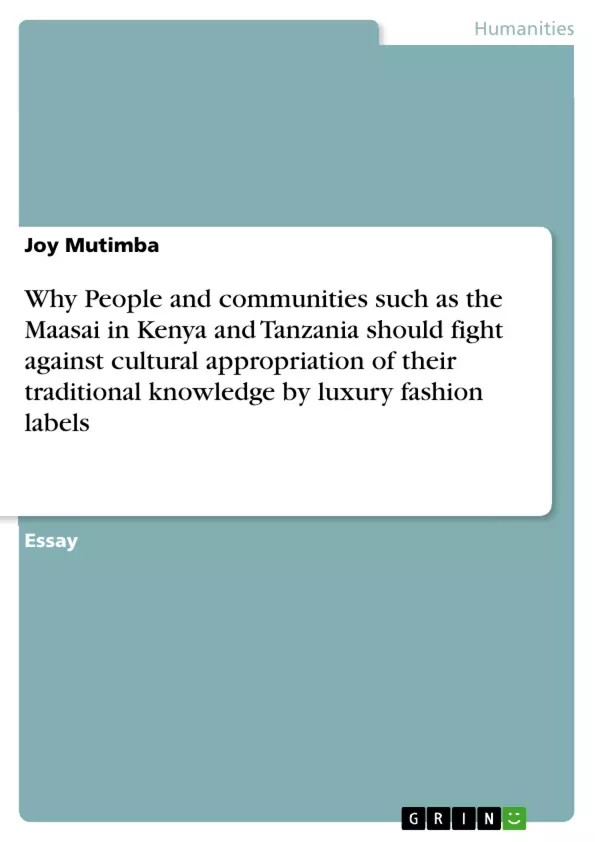Cultural appropriation is defined as taking intellectual property, traditional knowledge, cultural expressions or artefacts from someone else’s culture without permission. This also includes the unauthorised use of another’s culture’s dance, dress, music, language, folklore, cuisine, traditional medicine, religious symbols and the likes.
Any process of borrowing necessarily involves acts of appropriation, which are means by which borrowing occurs.
The first problem lies in the fact that developing countries like Kenya have not sufficiently defined their cultural industries within the Intellectual Property context. It is only recently that cultural industries have started realizing the full economic benefits that would be open to them, should they be granted adequate Intellectual Property protection and promotion.
Inhaltsverzeichnis (Table of Contents)
- Cultural Appropriation
- Intellectual Property Rights and Cultural Appropriation
- The Maasai Case: A Global Concern
- International Legal Framework
- Breaches of Intellectual Property Rights
- Maasai's Claim: A Legal Perspective
- Remedies
Zielsetzung und Themenschwerpunkte (Objectives and Key Themes)
This text aims to explore the issue of cultural appropriation by luxury fashion labels, particularly focusing on the Maasai community in Kenya and Tanzania. It examines the legal framework, including intellectual property rights, and the challenges faced by indigenous communities in protecting their cultural heritage.
- Cultural Appropriation and its Impacts
- Intellectual Property Rights in the Context of Traditional Knowledge
- Challenges Faced by Indigenous Communities in Protecting Their Cultural Heritage
- Legal and Ethical Considerations of Cultural Appropriation
- Possible Remedies and Solutions
Zusammenfassung der Kapitel (Chapter Summaries)
- Cultural Appropriation: This chapter introduces the concept of cultural appropriation and its definition, highlighting the unauthorized use of another culture's intellectual property, traditional knowledge, and cultural expressions.
- Intellectual Property Rights and Cultural Appropriation: This chapter explores the relationship between intellectual property rights and cultural appropriation, discussing the challenges in applying existing intellectual property frameworks to protect traditional knowledge and cultural expressions.
- The Maasai Case: A Global Concern: This chapter examines the case of the Maasai community and their struggle against cultural appropriation by luxury fashion labels, highlighting the economic and social impacts on the community.
- International Legal Framework: This chapter reviews the international legal framework, including the TRIPS Agreement and the UNESCO Universal Declaration on Cultural Diversity, and their implications for protecting cultural expressions.
- Breaches of Intellectual Property Rights: This chapter discusses the specific breaches of intellectual property rights that occur in the context of cultural appropriation, such as copyright infringement, design piracy, and trademark dilution.
- Maasai's Claim: A Legal Perspective: This chapter analyzes the legal claim of the Maasai community against the offending companies, drawing parallels with similar cases like the Navajo Nation v Urban Outfitters lawsuit.
Schlüsselwörter (Keywords)
The main keywords and focus topics of this text include cultural appropriation, intellectual property rights, traditional knowledge, indigenous communities, Maasai, legal framework, trademark, copyright, design, exploitation, remedies, and benefit sharing.
- Quote paper
- Joy Mutimba (Author), 2018, Why People and communities such as the Maasai in Kenya and Tanzania should fight against cultural appropriation of their traditional knowledge by luxury fashion labels, Munich, GRIN Verlag, https://www.grin.com/document/420576



